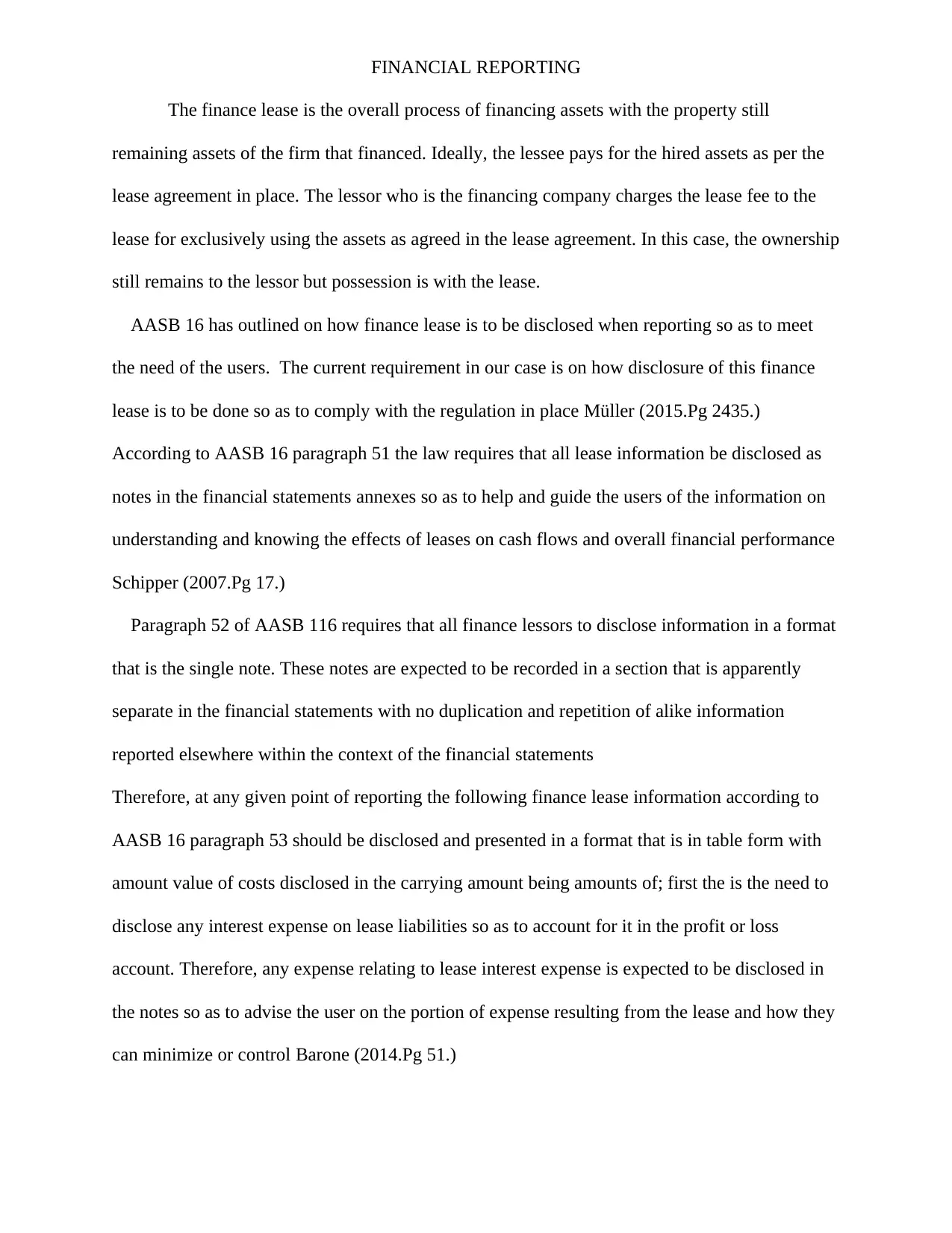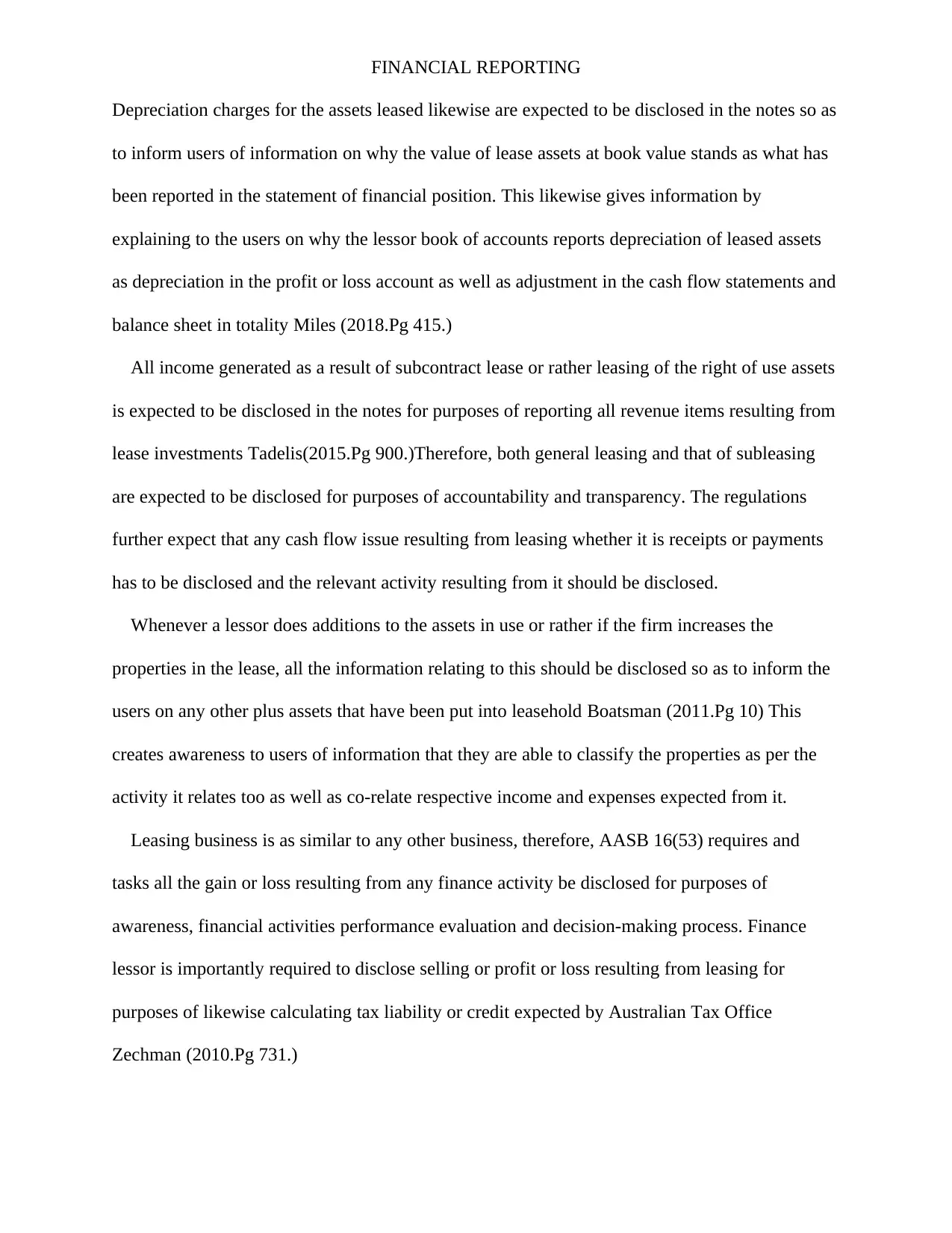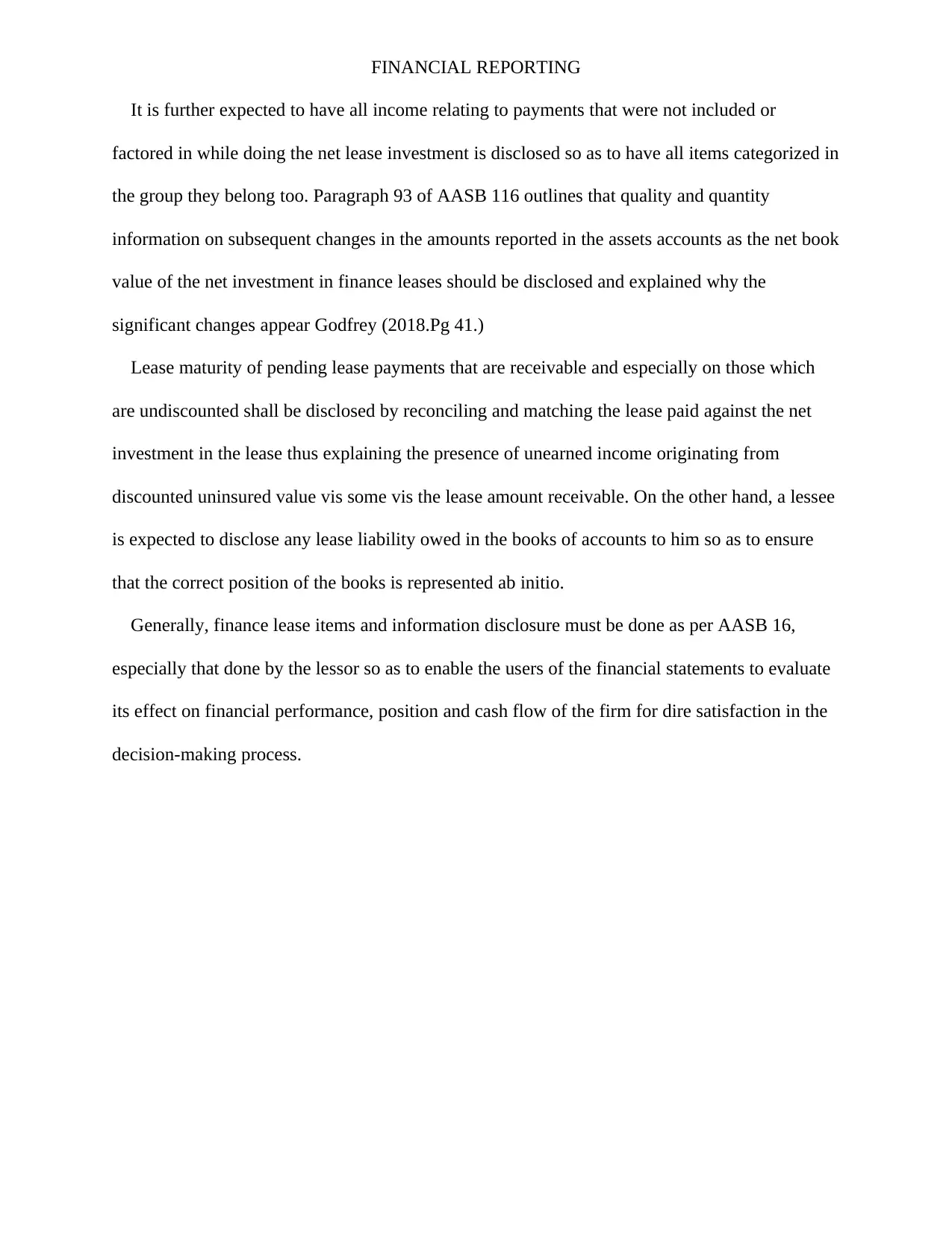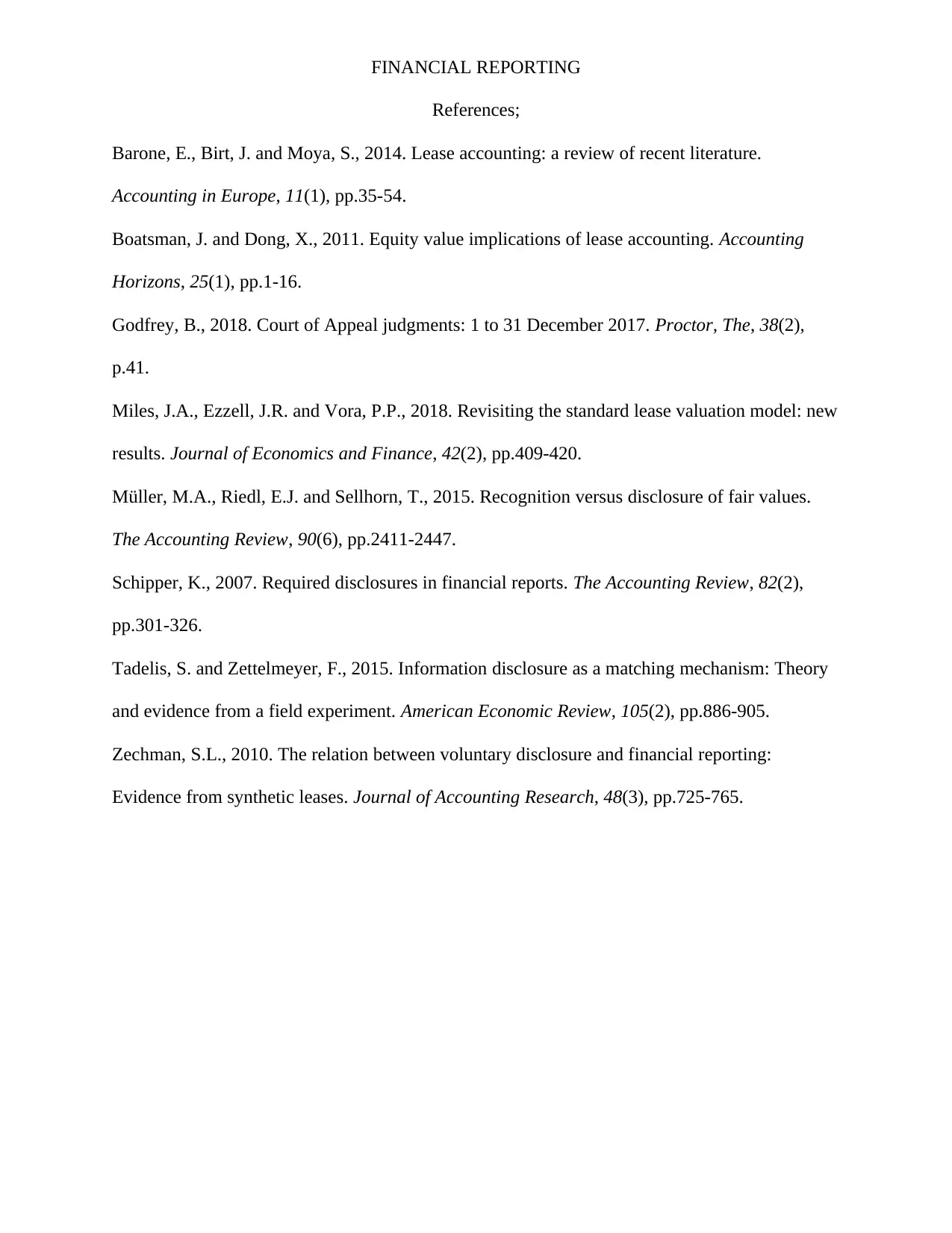Detailed Analysis of Australian Finance Lease Disclosure Requirements
VerifiedAdded on 2021/06/16
|5
|1228
|16
Report
AI Summary
This report provides a detailed analysis of the Australian finance lease disclosure requirements as per AASB 16. It explains the definition of finance leases, highlighting that the ownership of the assets remains with the lessor while the lessee pays for the asset use. The report emphasizes the importance of disclosure to help users understand the effects of leases on cash flows and financial performance. It outlines specific disclosure requirements, including interest expense, depreciation charges, income from subleases, cash flow issues, additions to leased assets, gains or losses from finance activities, and lease maturity details. The report references key paragraphs from AASB 16 and supports its points with several academic references. This report serves as a valuable guide for understanding the necessary disclosures for finance leases in the Australian context.

FINANCIAL REPORTING
AUSTRALIAN FINANCE LEASE DISCLOSURE
Name
Course:
Professor’s Name
Institution
City
Date
AUSTRALIAN FINANCE LEASE DISCLOSURE
Name
Course:
Professor’s Name
Institution
City
Date
Paraphrase This Document
Need a fresh take? Get an instant paraphrase of this document with our AI Paraphraser

FINANCIAL REPORTING
The finance lease is the overall process of financing assets with the property still
remaining assets of the firm that financed. Ideally, the lessee pays for the hired assets as per the
lease agreement in place. The lessor who is the financing company charges the lease fee to the
lease for exclusively using the assets as agreed in the lease agreement. In this case, the ownership
still remains to the lessor but possession is with the lease.
AASB 16 has outlined on how finance lease is to be disclosed when reporting so as to meet
the need of the users. The current requirement in our case is on how disclosure of this finance
lease is to be done so as to comply with the regulation in place Müller (2015.Pg 2435.)
According to AASB 16 paragraph 51 the law requires that all lease information be disclosed as
notes in the financial statements annexes so as to help and guide the users of the information on
understanding and knowing the effects of leases on cash flows and overall financial performance
Schipper (2007.Pg 17.)
Paragraph 52 of AASB 116 requires that all finance lessors to disclose information in a format
that is the single note. These notes are expected to be recorded in a section that is apparently
separate in the financial statements with no duplication and repetition of alike information
reported elsewhere within the context of the financial statements
Therefore, at any given point of reporting the following finance lease information according to
AASB 16 paragraph 53 should be disclosed and presented in a format that is in table form with
amount value of costs disclosed in the carrying amount being amounts of; first the is the need to
disclose any interest expense on lease liabilities so as to account for it in the profit or loss
account. Therefore, any expense relating to lease interest expense is expected to be disclosed in
the notes so as to advise the user on the portion of expense resulting from the lease and how they
can minimize or control Barone (2014.Pg 51.)
The finance lease is the overall process of financing assets with the property still
remaining assets of the firm that financed. Ideally, the lessee pays for the hired assets as per the
lease agreement in place. The lessor who is the financing company charges the lease fee to the
lease for exclusively using the assets as agreed in the lease agreement. In this case, the ownership
still remains to the lessor but possession is with the lease.
AASB 16 has outlined on how finance lease is to be disclosed when reporting so as to meet
the need of the users. The current requirement in our case is on how disclosure of this finance
lease is to be done so as to comply with the regulation in place Müller (2015.Pg 2435.)
According to AASB 16 paragraph 51 the law requires that all lease information be disclosed as
notes in the financial statements annexes so as to help and guide the users of the information on
understanding and knowing the effects of leases on cash flows and overall financial performance
Schipper (2007.Pg 17.)
Paragraph 52 of AASB 116 requires that all finance lessors to disclose information in a format
that is the single note. These notes are expected to be recorded in a section that is apparently
separate in the financial statements with no duplication and repetition of alike information
reported elsewhere within the context of the financial statements
Therefore, at any given point of reporting the following finance lease information according to
AASB 16 paragraph 53 should be disclosed and presented in a format that is in table form with
amount value of costs disclosed in the carrying amount being amounts of; first the is the need to
disclose any interest expense on lease liabilities so as to account for it in the profit or loss
account. Therefore, any expense relating to lease interest expense is expected to be disclosed in
the notes so as to advise the user on the portion of expense resulting from the lease and how they
can minimize or control Barone (2014.Pg 51.)

FINANCIAL REPORTING
Depreciation charges for the assets leased likewise are expected to be disclosed in the notes so as
to inform users of information on why the value of lease assets at book value stands as what has
been reported in the statement of financial position. This likewise gives information by
explaining to the users on why the lessor book of accounts reports depreciation of leased assets
as depreciation in the profit or loss account as well as adjustment in the cash flow statements and
balance sheet in totality Miles (2018.Pg 415.)
All income generated as a result of subcontract lease or rather leasing of the right of use assets
is expected to be disclosed in the notes for purposes of reporting all revenue items resulting from
lease investments Tadelis(2015.Pg 900.)Therefore, both general leasing and that of subleasing
are expected to be disclosed for purposes of accountability and transparency. The regulations
further expect that any cash flow issue resulting from leasing whether it is receipts or payments
has to be disclosed and the relevant activity resulting from it should be disclosed.
Whenever a lessor does additions to the assets in use or rather if the firm increases the
properties in the lease, all the information relating to this should be disclosed so as to inform the
users on any other plus assets that have been put into leasehold Boatsman (2011.Pg 10) This
creates awareness to users of information that they are able to classify the properties as per the
activity it relates too as well as co-relate respective income and expenses expected from it.
Leasing business is as similar to any other business, therefore, AASB 16(53) requires and
tasks all the gain or loss resulting from any finance activity be disclosed for purposes of
awareness, financial activities performance evaluation and decision-making process. Finance
lessor is importantly required to disclose selling or profit or loss resulting from leasing for
purposes of likewise calculating tax liability or credit expected by Australian Tax Office
Zechman (2010.Pg 731.)
Depreciation charges for the assets leased likewise are expected to be disclosed in the notes so as
to inform users of information on why the value of lease assets at book value stands as what has
been reported in the statement of financial position. This likewise gives information by
explaining to the users on why the lessor book of accounts reports depreciation of leased assets
as depreciation in the profit or loss account as well as adjustment in the cash flow statements and
balance sheet in totality Miles (2018.Pg 415.)
All income generated as a result of subcontract lease or rather leasing of the right of use assets
is expected to be disclosed in the notes for purposes of reporting all revenue items resulting from
lease investments Tadelis(2015.Pg 900.)Therefore, both general leasing and that of subleasing
are expected to be disclosed for purposes of accountability and transparency. The regulations
further expect that any cash flow issue resulting from leasing whether it is receipts or payments
has to be disclosed and the relevant activity resulting from it should be disclosed.
Whenever a lessor does additions to the assets in use or rather if the firm increases the
properties in the lease, all the information relating to this should be disclosed so as to inform the
users on any other plus assets that have been put into leasehold Boatsman (2011.Pg 10) This
creates awareness to users of information that they are able to classify the properties as per the
activity it relates too as well as co-relate respective income and expenses expected from it.
Leasing business is as similar to any other business, therefore, AASB 16(53) requires and
tasks all the gain or loss resulting from any finance activity be disclosed for purposes of
awareness, financial activities performance evaluation and decision-making process. Finance
lessor is importantly required to disclose selling or profit or loss resulting from leasing for
purposes of likewise calculating tax liability or credit expected by Australian Tax Office
Zechman (2010.Pg 731.)
⊘ This is a preview!⊘
Do you want full access?
Subscribe today to unlock all pages.

Trusted by 1+ million students worldwide

FINANCIAL REPORTING
It is further expected to have all income relating to payments that were not included or
factored in while doing the net lease investment is disclosed so as to have all items categorized in
the group they belong too. Paragraph 93 of AASB 116 outlines that quality and quantity
information on subsequent changes in the amounts reported in the assets accounts as the net book
value of the net investment in finance leases should be disclosed and explained why the
significant changes appear Godfrey (2018.Pg 41.)
Lease maturity of pending lease payments that are receivable and especially on those which
are undiscounted shall be disclosed by reconciling and matching the lease paid against the net
investment in the lease thus explaining the presence of unearned income originating from
discounted uninsured value vis some vis the lease amount receivable. On the other hand, a lessee
is expected to disclose any lease liability owed in the books of accounts to him so as to ensure
that the correct position of the books is represented ab initio.
Generally, finance lease items and information disclosure must be done as per AASB 16,
especially that done by the lessor so as to enable the users of the financial statements to evaluate
its effect on financial performance, position and cash flow of the firm for dire satisfaction in the
decision-making process.
It is further expected to have all income relating to payments that were not included or
factored in while doing the net lease investment is disclosed so as to have all items categorized in
the group they belong too. Paragraph 93 of AASB 116 outlines that quality and quantity
information on subsequent changes in the amounts reported in the assets accounts as the net book
value of the net investment in finance leases should be disclosed and explained why the
significant changes appear Godfrey (2018.Pg 41.)
Lease maturity of pending lease payments that are receivable and especially on those which
are undiscounted shall be disclosed by reconciling and matching the lease paid against the net
investment in the lease thus explaining the presence of unearned income originating from
discounted uninsured value vis some vis the lease amount receivable. On the other hand, a lessee
is expected to disclose any lease liability owed in the books of accounts to him so as to ensure
that the correct position of the books is represented ab initio.
Generally, finance lease items and information disclosure must be done as per AASB 16,
especially that done by the lessor so as to enable the users of the financial statements to evaluate
its effect on financial performance, position and cash flow of the firm for dire satisfaction in the
decision-making process.
Paraphrase This Document
Need a fresh take? Get an instant paraphrase of this document with our AI Paraphraser

FINANCIAL REPORTING
References;
Barone, E., Birt, J. and Moya, S., 2014. Lease accounting: a review of recent literature.
Accounting in Europe, 11(1), pp.35-54.
Boatsman, J. and Dong, X., 2011. Equity value implications of lease accounting. Accounting
Horizons, 25(1), pp.1-16.
Godfrey, B., 2018. Court of Appeal judgments: 1 to 31 December 2017. Proctor, The, 38(2),
p.41.
Miles, J.A., Ezzell, J.R. and Vora, P.P., 2018. Revisiting the standard lease valuation model: new
results. Journal of Economics and Finance, 42(2), pp.409-420.
Müller, M.A., Riedl, E.J. and Sellhorn, T., 2015. Recognition versus disclosure of fair values.
The Accounting Review, 90(6), pp.2411-2447.
Schipper, K., 2007. Required disclosures in financial reports. The Accounting Review, 82(2),
pp.301-326.
Tadelis, S. and Zettelmeyer, F., 2015. Information disclosure as a matching mechanism: Theory
and evidence from a field experiment. American Economic Review, 105(2), pp.886-905.
Zechman, S.L., 2010. The relation between voluntary disclosure and financial reporting:
Evidence from synthetic leases. Journal of Accounting Research, 48(3), pp.725-765.
References;
Barone, E., Birt, J. and Moya, S., 2014. Lease accounting: a review of recent literature.
Accounting in Europe, 11(1), pp.35-54.
Boatsman, J. and Dong, X., 2011. Equity value implications of lease accounting. Accounting
Horizons, 25(1), pp.1-16.
Godfrey, B., 2018. Court of Appeal judgments: 1 to 31 December 2017. Proctor, The, 38(2),
p.41.
Miles, J.A., Ezzell, J.R. and Vora, P.P., 2018. Revisiting the standard lease valuation model: new
results. Journal of Economics and Finance, 42(2), pp.409-420.
Müller, M.A., Riedl, E.J. and Sellhorn, T., 2015. Recognition versus disclosure of fair values.
The Accounting Review, 90(6), pp.2411-2447.
Schipper, K., 2007. Required disclosures in financial reports. The Accounting Review, 82(2),
pp.301-326.
Tadelis, S. and Zettelmeyer, F., 2015. Information disclosure as a matching mechanism: Theory
and evidence from a field experiment. American Economic Review, 105(2), pp.886-905.
Zechman, S.L., 2010. The relation between voluntary disclosure and financial reporting:
Evidence from synthetic leases. Journal of Accounting Research, 48(3), pp.725-765.
1 out of 5
Related Documents
Your All-in-One AI-Powered Toolkit for Academic Success.
+13062052269
info@desklib.com
Available 24*7 on WhatsApp / Email
![[object Object]](/_next/static/media/star-bottom.7253800d.svg)
Unlock your academic potential
Copyright © 2020–2025 A2Z Services. All Rights Reserved. Developed and managed by ZUCOL.




